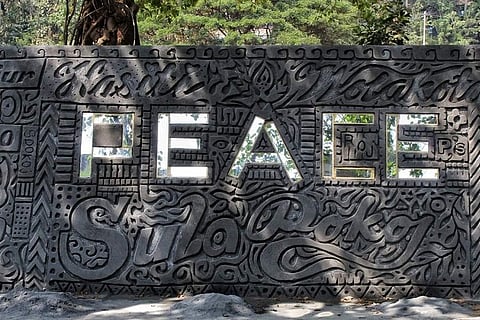

Ten years ago, when he was thinking of the books he read as a child and of the history he knew of his homeland, artist Suresh K Nair wanted to put it all on a wall somewhere. That’s what he does – paint murals on public walls. Before that, he had not thought of the Cherupulassery High School, just 5 km from his home, Adakkaputhur in Palakkad. The school’s walls were large, several hundred feet long, and Suresh could carve or paint all he wanted. But back then the school principal said there were just no funds. That changed last year when the government school got private funds as part of a new programme. Suresh was called again, asked about the project he had so fondly spoken of before. It was possible to achieve it now.
Suresh, a professor at Banaras University, wasted no time. December last, he came home to Palakkad with 15 of his students and together they set to work outside the walls of the Cherupulassery government school. A ‘peace’ wall of art was carved in 12 days, which would in a few days be painted too. Among all the different pictures made on 26 frames, the word ‘peace’ sits large on top. Suresh had not planned it in recent times, but the word peace sits aptly on the wall only days after there were anxieties of a war, as tension simmered on the border between India and Pakistan. But Suresh had dreamt of this wall of art a long time ago.
Suresh K Nair works on the peace wall in Cherupulassery
“The idea had formed in my head when I was very young, when as a student I read a book from the school library on Cherupulassery’s role in the freedom struggle of the country. What struck me most was a book called Kilafath Smaranakal written by freedom fighter Mozhikunnam Brahmadathan Namboodiripad. It describes how the British misunderstood him and tied him to a horse and dragged him to prison. It created some disturbing visuals in my mind even back then. It is his story that we have carved on one part of the wall,” says Suresh, who is on a break from work at his home in Adakkaputhur.
I call him at a really bad time. His mother had just passed away on Saturday and Suresh was talking to the many who came to pay their last respects. But he finds time on an evening to talk of his ‘peace wall’ that has by now found mention in most dailies. Suresh sends me the many stories which have appeared already. Perhaps he doesn’t want to repeat it all again. He talks of how he carved on the wall the word peace in 250 languages, and one of them in mirror. “The English one is done using mirrors. I might have been influenced by Sree Narayana Guru who installed mirrors in place of deities, with the idea that if one wants to see god, one should look at oneself. With this same idea, I had once – when I was an art student at Tagore’s Santiniketan – made an installation of my form with mirrors,” Suresh says.
Suresh, as a student in Santiniketan, created an installation of his form with mirrors
He was eating a lot then – plus 20 cups of tea a day from the campus canteen – and thought of a way to bring some control. “I ate just fruits and drank tender coconut water for 30 days. On the 30th day I felt weightless, transparent, and all the negativity released. I felt I was reflected everywhere and I wanted to convert that feeling to a work of art. That’s how I made the mural work of my form in mirrors back in the year 2000.”
After that, Suresh’s paintings went far and wide, for exhibitions inside and outside the country, but he was always attracted to the public walls, not the insides of galleries. “I had for five years learnt mural painting from the Institute of Mural Painting in Guruvayoor where they teach you to paint murals of gods and goddesses inside temples. After that, for seven years I went to the Visvabharati University (Santiniketan) and learnt how to work in public spaces. It was about taking your work from private spaces and religious backgrounds to the public,” he says.
Even before the Cherupulassery work, Suresh has created another ‘peace’ art work at a public space – at the Wagah border! Made in October 2014, it’s a cement mural on a 200 feet long wall that had four parts – pre-partition, partition, post-partition and the present state. “It happened when an IAS officer visited Banaras University, saw my work and invited me there.”
Brahmadathan Namboothiripad carved on the wall
The one in Kerala is even bigger – 700 feet long. Along with Brahmadathan Namboodiripad and 250 carvings of peace, there appears other local history on the walls – of Mahatma Gandhi visiting, Subhash Chandra Bose visiting, of the Mappila Lahala. Suresh was apprehensive whether the idea might be rejected, but ‘peace’ always finds a way. Cement got carved on 26 frames, with the help of 13 of his students from Banaras University, and two others from the Kalady Sankaracharya University where the professor had taught once. For the cementing work, he also took the help of some labourers and masons in the neighbourhood.
Suresh's students at work
“University education has become something like going to the bank – starts at 10 am and ends at 4 pm. There’s no freedom for the students. When you bring them out of the classroom, they get time, freedom and a way to express. It is during their holidays that I have brought them here. Some of them are financially not so well off, I have arranged stay, food and a remuneration for them,” Suresh says.